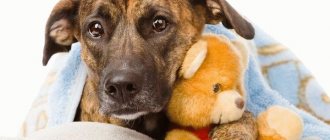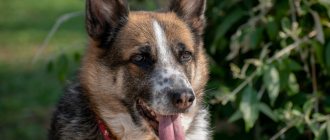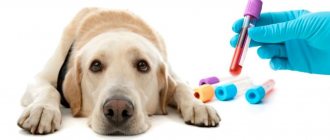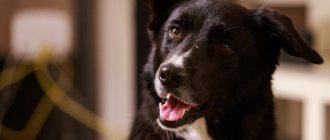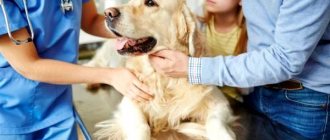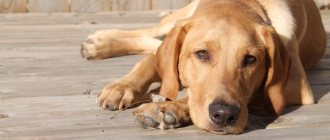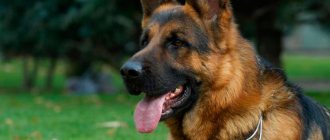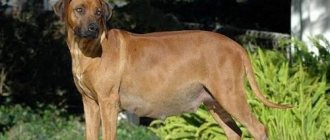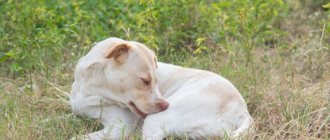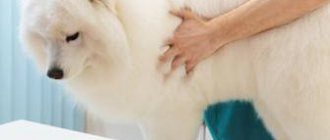Taking care of your pet's health is an important part of caring for your dog. Most owners pay close attention to the well-being of their pet and are ready to run to the doctor as soon as their beloved four-legged friend falls ill.
However, there are symptoms that are not so easy to discern even for a knowledgeable and attentive owner. What hidden signs of illness may indicate that not everything is all right with your four-legged friend?
Increased thirst. If increased fluid intake is not associated with high room temperatures or excessively salty foods, thirst may be a sign of increased toxins in the body or endocrine system dysfunction. Another serious disease in which this symptom appears is kidney failure, leading to severe damage to the urinary system and even death of the pet. In any case, if the thirst does not go away within a day or two, we advise you to immediately show your dog to a veterinarian.
Frequent urination. Often increased thirst is accompanied by a frequent urge to urinate. It is difficult to ignore this symptom, but most owners do not consider it a sign of a serious illness. In fact, this phenomenon may be a sign of cystitis (if the urge is frequent and the amount of urine released is insignificant) or urinary incontinence.
Pallor or even blueness of the mucous membranes. This symptom is usually accompanied by weakness and a staggering gait. If at the same time you notice that your dog’s belly is increasing in volume, go to the veterinarian without wasting a minute. All these are signs of severe internal bleeding, in which life can count for hours.
Lack of appetite. This is a truly serious symptom for a responsible owner. The first thing to do if the dog refuses to eat is to examine the animal’s body in search of a tick, because lack of appetite and lethargy are one of the first signs of piroplasmosis. However, even if you don’t find a parasite, you shouldn’t relax - watch your dog carefully and, if you notice other signs of ill health, immediately run to the doctor. To be fair, it must be said that our beloved pets often refuse food, even when they are completely healthy. It is quite possible that the dog simply decided to have a fasting day.
Increased appetite, accompanied by a sharp weight loss of the animal, may be a sign of diabetes mellitus or helminthic infestation. In the first case, the pet needs carefully calculated insulin therapy, and in the second you will have to rid it of internal parasites.
Hair loss all over the body and the appearance of large dandruff. These symptoms of demodicosis may also be accompanied by itching and general nervousness of the dog. If you notice one or more of these signs, submit a deep scraping from your pet’s skin to a veterinary laboratory - treatment directly depends on the type and number of demodectic mites that have infected the dog.
Frequent vomiting and loose stools, especially on an empty stomach. Often, owners do not pay attention to vomiting and diarrhea, justifying it with banal overeating or the ingestion of not entirely fresh food. In fact, such symptoms, which are repeated with enviable regularity, most often indicate severe damage to the digestive system such as gastritis, pancreatitis or cholecystitis. Despite the fact that your pet is not in immediate danger of death, it would be a good idea to consult a doctor as soon as possible and prescribe treatment with enzymes.
Increased salivation. Increased salivation can occur with sunstroke or heatstroke, as well as with injuries to the tongue and oral cavity. Another reason for this phenomenon is the entry of a foreign body into the dog’s stomach; in this case, there is also frequent regurgitation of freshly eaten food and water.
Inflammation of the mucous membrane of the eyes. In addition to a foreign body or staphylococcal infection, eye inflammation can be a sign of liver disease or gallbladder pathology. If all kinds of eye treatments do not bring results, try to look at liver indicators in tests and, if necessary, begin treatment for this vital organ.
Lameness. In addition to the expected bruise or fracture, a dog can limp due to such an insidious and invisible disease as arthritis. In this case, this sign occurs in damp, cold weather or in case of sudden hypothermia of the animal. If your four-legged friend runs with his hind legs together like a hare, this is a clear symptom of hip dysplasia, an incurable hereditary disease that requires lifelong therapy.
Cough and respiratory distress, especially in an older dog. Such symptoms indicate acute or chronic heart failure, as well as fluid accumulation in the chest.
Purulent discharge from the loop. Most owners know how dangerous pyometra is - purulent inflammation of the uterus in dogs. And that the first sign of this disease is purulent discharge from the vagina of a bitch. However, few people are able to notice such a symptom in time, paying little attention to what is happening under the tail of their beloved dog.
The animal behaves restlessly at night, whining or walking in circles around the room. Such signs are not a whim at all, but rather well-known symptoms of increased intracranial pressure. It can occur after epileptic seizures, trauma, or problems with the heart or blood vessels. This condition can be diagnosed by CT or MRI, carried out in all major veterinary clinics.
Unnatural dog posture while resting. An animal that is not bothered by anything rests and moves naturally. The dog sleeps curled up in a tight ball when it is cold and stretches out its limbs in a warm room. In case of any pain syndrome, the animal takes a forced position, in which the pain is reduced and the unpleasant symptoms disappear. If you notice that your pet is sleeping or walking differently than before, be sure to show him to the veterinarian, perhaps something is really bothering him.
Yellowness of the mucous membranes and skin. This symptom is difficult to notice, especially on black animals. However, an attentive owner will notice that the sclera of the pet’s eyes and gums have acquired an unhealthy yellowish color. Most often, such jaundice is provoked by liver diseases, including cirrhosis, so do not delay your visit to the veterinarian. However, such a symptom can also arise for a completely innocent reason. Yellowness of an animal's skin may indicate an excess of carotene in the body. Of course, any hypervitaminosis is an unpleasant phenomenon and requires nutritional correction, however, compared to cirrhosis, it is a fairly innocent thing.
Pica. A dog's devouring of all kinds of inedible objects is most often provoked not by a lack of education, as some people think, but by serious health problems. Most likely, your pet is worried about digestive disorders, however, a perverted appetite can also be a sign of more serious diseases - for example, rabies.
Most of the symptoms presented above may well be harmless in nature and are not signs of serious diseases. However, the health of your beloved pet is not a matter of guesswork or hope. If you see any of them or feel that the dog’s behavior has changed, immediately show it to a doctor. Even if the alarm was false, you will get rid of worries, and the slightest unpleasant surprise will not take you by surprise.
Psychological causes of restless behavior in dogs
If you notice that the dog is acting restless, agitated, or that something is bothering the dog, it is very important to determine the source of stress and the cause of such behavior.
Important! Stress weakens resistance, immune potential, slows down the processes of recovery and regeneration in the body. Stress hormones disrupt water-salt balance, metabolism, and increase susceptibility to infectious, viral and bacterial diseases.
If a dog whines, behaves restlessly, follows the owner’s heels, the owners most often attribute such animal behavior to stress, the pet’s whims, or seeking attention.
Psychological causes of restless behavior in dogs can be caused by:
- an overabundance of emotions (a long-awaited meeting with the owner after separation);
- rude attitude;
- transportation;
- visiting a veterinary clinic, exhibitions;
- change of owners;
- moving to a new place of residence;
- the appearance of other pets in the house;
- jealousy;
- lack of sleep;
- fight with dogs;
- changing your usual lifestyle;
- bad atmosphere in the house (quarrels between household members);
- excess, lack of activity, mental stress;
- breed predisposition;
- age-related disorders of the central nervous system and brain;
- hormonal imbalance (pregnancy, lactation, childbirth, sexual heat, rutting);
- lack or deficiency of communication with the owner.
Loud noise, fireworks, firecrackers, loud sounds, noise affect the psycho-emotional state of the dog, causing stress. Grooming and hygiene procedures can also cause stress and restless behavior in a dog.
Important! All breeds are susceptible to stress, but the most mobile psyche is found in dogs of decorative, miniature breeds and their mixed breeds.
Dogs are social, highly organized animals with different temperaments and mental types. Our pets experience nervous tension, suffer from phobias, and are sensitive to the environment and the effects of irritants. Animals are also diagnosed with nervous disorders of various origins and etiologies.
It should also be noted that dogs feel our mood, emotions, and if something is wrong with the owner, the devoted dog experiences discomfort and begins to get nervous.
What is better not to do?
However, there are some things you should definitely avoid when your dog is this hyperactive: Don't chase him. This can send a bad behavioral signal, especially if this is a puppy that is just learning how to function properly in the world. Instead, if you need to stop the zoomie, say the dog's name out loud. Hopefully this will awaken her to obedience.
Restless behavior as a sign of illness
Often the dog behaves restlessly due to the influence of so-called internal stress factors. That is, due to poor health, health problems.
Restless behavior as a sign of disease in dogs is noted when:
- neuroses, nervous disorders, pathologies;
- viral-bacterial, parasitic infections, which are accompanied by damage to the central and peripheral nervous system;
- renal colic;
- chronic, acute renal, liver failure;
- allergic manifestations (food allergies);
- disturbances in the gastrointestinal tract (acute intestinal disorder, food poisoning, chemicals, gastric volvulus);
- inflammation, blockage of the paraanal glands.
The dog may experience anxiety due to helminthic infestation, mycoses, dermatitis, dermatoses, or due to infection with ectoparasites.
How to cope with an irritant?
Treatment for a nervous disorder is selected individually. It is important to build on the pet’s reaction. For some, one method of exposure is enough, while for others only complex therapy helps.
Start with positive emotions. Arrange pleasant meetings and new acquaintances. Treat your pet to unusual delicacies and delight with a variety of toys. Switching from a depressing problem helps a lot during a protracted crisis.
See occupational therapy. Playing sports, learning new teams and going for walks accompanied by games are another way to overcome a crisis situation. Reward your initiative with praise or treats.
In some cases, you cannot do without the help of a veterinarian. He will tell you what to do if the dog is stressed and there is no time left for a long struggle. Sedatives will help you cope with the anxiety associated with a quick trip or going to a preventive examination. They calm the animal, relieving the main symptoms.
Unfortunately, drops and tablets are only a temporary solution. Sedatives are prohibited during pregnancy and early childhood, and their prolonged use has a negative impact on health.
Additional symptoms and their explanation
In addition to anxiety, you can understand that a pet is unwell by the symptoms characteristic of a particular disease.
Symptoms of nervousness:
- profuse salivation;
- sudden mood swings;
- faded wool;
- pale, icteric mucous membranes;
- muscle spasms;
- licking;
- itching, gnawing, licking fur until bald spots appear on the body;
- muscle spasms, cramps;
- depression, apathy, drowsiness;
- uncontrolled urination, defecation;
- digestive disorders (vomiting, nausea);
- change in color of urine, feces;
- unstable temperature;
- skin rash;
- unpleasant odor coming from the dog;
- discharge from the nose, eyes;
- refusal of food or, on the contrary, increased appetite, thirst.
The dog is rushing about and cannot find a place for itself
Pets experience panic for one reason or another. If a dog rushes about and cannot find a place for itself, does not listen, does not respond to commands, and constantly changes positions - this is a manifestation of severe stress, anxiety, fear, and pain.
Observe the animal, analyze what could cause this behavior. The dog was frightened by the noise or is this a reaction to another strong irritant. If after a while the animal does not calm down, or signs are uncharacteristic for a healthy dog, contact your veterinarian. The dog cannot tell that something hurts, so it tries to attract our attention with such behavior.
The dog is restless at night
If your dog is acting restless at night, possible reasons include:
- moving to a new place;
- stress;
- non-compliance with the daily routine;
- lack of physical activity;
- fright;
- emotional experiences.
The dog may worry at night due to pain or the development of any diseases. For example, a dog may have a stomach ache or a fever. In bitches, this behavior can be caused by false pregnancy and early weaning of puppies.
The animal is itching
If an animal itches, these are signs of stress and neurosis. With prolonged exposure to stress factors, in addition to itching, the dog begins to frantically lick itself, gnawing, and behaves restlessly. Bald spots appear on the body, the coat loses its shine.
Itching is caused by ecto-endoparasites, allergic manifestations, dermatitis (demodex, trichophytosis, atopic dermatitis), endocrinological, sexual pathologies, endoparasites.
To get to the bottom of the cause, carefully examine the dog’s body for the presence of rashes and parasites, observe its behavior, and show it to the veterinarian.
Before traveling or in the car
As a rule, dogs, if accustomed to a car, tolerate travel well and travel with pleasure with their owners. But there are pets who are very nervous during transportation or before a trip.
A day before, you can give a mild sedative in drops or tablets. To prevent your dog from getting motion sickness, do not feed or give a lot of water before the trip. Take food, drinking water, antiemetic and antiemetic medications with you.
Control and calm your pet. Make stops. Don't leave your dog in a locked car in the heat. If your dog vomits, do not scold him, but use commands to stop negative actions.
Advice! After traveling, give your dog sedatives for 2 days.
Breathes frequently with mouth open
Normally, at rest, the dog makes 10-30 respiratory movements (inhalation/exhalation) per minute. Breathing disorders can be caused by natural, physiological causes or pathological factors.
Respiratory dysfunction is noted when:
- allergies;
- heart pathologies;
- overweight, obesity;
- poisoning, intoxication;
- high temperature;
- diseases of the genitourinary tract.
Rapid breathing (tachypnea) is a symptom of respiratory infections. For sternum injuries, inflammatory processes, neoplasms in the organs of the respiratory tract, disruption of their innervation.
Tail between legs
In dog language, a tucked tail means that the dog is too scared of something, is experiencing discomfort, restlessness, anxiety, or has suffered stress. By tucking its tail, the pet demonstrates humility and shows that it realizes that it has offended its owner.
Important! The tail in dogs is an organ for maintaining balance and expressing emotions. By the position of the tail, the owner and other dogs can determine the dog’s mood and the state of the nervous system.
But there are also pathological reasons for which the dog lowers his tail and tucks his tail (hypoglycemia, poor health, spinal injuries, pain syndrome).
Interesting! In some breeds, a tail tucked close to the belly is a breed feature (hounds, slugs, whippets, salukis).
The dog hides in a secluded place
Dogs have many reasons for seeking out quiet, peaceful places. Behavior problems. The dog has misbehaved and, in order to avoid punishment, is looking for a secluded corner, an increased degree of emotionality, the first days in a new home, anxiety. Perhaps the dog just wants to retire, relax, sleep, or the animal does not have an equipped place to rest or sleep.
Important! The desire to hide in animals is justified by instincts, negative experiences, and physiological needs.
If the dog hides in a secluded place, hides in a corner, climbs under furniture, and you are absolutely sure that there are no stress factors, the reasons for this behavior may indicate health problems.
If the dog does not respond to stimuli, growls, shows aggression, does not allow him to approach him, refuses to eat, looks lethargic, apathetic, you need to establish the root cause of this behavior as quickly as possible by contacting a veterinarian.
The dog is shaking all over
If your dog is shaking all over, possible reasons include:
- fear, emotional stress;
- stress;
- allergy;
- hypothermia;
- intoxication;
- parasitic diseases, infections;
- nervous disorders;
- inflammatory processes;
- diseases of the cardiovascular system.
Trembling, which is not accompanied by any symptoms, indicates a violation of hypo-calcium metabolism in the dog’s body, insulin deficiency (diabetes mellitus), endocrine, hormonal disruptions.
Interesting! Among the breeds that shake frequently are Yorkshire terriers, miniature pinschers, poodles, and Pomeranians.
Doggies experience tremor of the whole body or limbs. These breeds have an active psyche, are very emotional, and do not tolerate sub-zero temperatures and cold.
Follows the owner
If the dog follows the owner, it is possible that the animal requires attention, is looking for support, if it is frightened by something, or has suffered stress. Perhaps the dog is too oriented and emotionally dependent on the owner or makes sure that everything is in order with the owner and takes part in his life.
Such behavior may also mean that the dog is scared of something and is looking for support and protection from you.
Refuses to eat or does not drink
If the dog does not eat or drink, the reasons can be very different. Stress, emotional stress, heat - these are the most harmless reasons for lack of appetite. As a rule, refusal of food and water signals serious disorders and illnesses. Poisoning, intoxication, shock, high temperature, infections, disruptions in the gastrointestinal tract.
If the dog refuses to eat or does not drink, whatever the reason, we strongly recommend that you take the dog to a veterinarian. It is necessary to establish the cause as quickly as possible and do everything to normalize the pet’s condition.
Always digging for something
Many owners begin to panic when they notice that their dog is constantly “digging” for something (the ground, the floor, digging up the bed).
If the dog digs, some of the reasons include:
- The dog doesn't feel safe.
- Sets up a lair. This behavior is typical for bitches before giving birth and females suffering from false pregnancy.
- Stress, fear, emotional tension.
- Mental problems, nervous disorder.
- Boredom, melancholy.
- Banal curiosity.
Similar behavior is observed in hyperactive dogs that lack physical and mental stress.
The dog whines, barks for no reason or howls
Dogs bark have different intonations. They make many different sounds, demonstrating their emotions and conveying information. But if the dog whines, barks for no reason or howls, you need to establish the reason.
Reasons for whining:
- emotional overexcitation;
- to attract attention;
- the need to satisfy physiological needs;
- boredom, melancholy;
- guilt.
Dogs howl when they experience fear, discomfort, and anxiety. They attract the attention of their owners, experiencing a lack of communication. It is possible that the dog is in pain. Carefully observe your pet and its behavior. If a dog constantly howls, whines, or barks, it means that something is bothering him.
Sleep standards for four-legged animals
Many owners have noticed that puppies always sleep longer than adults. This is explained by the characteristics of their body.
INTERESTING!
According to research by the American National Sleep Foundation, our four-legged pets sleep 50% of the time. They devote the remaining 20% to an active lifestyle, and 30% to just lying around, but being awake.
For puppies
Unlike an adult animal, a newborn puppy actually sleeps almost all day. He spends 90% of his time on this, interrupting only for feeding.
In the first 12 weeks, its norm is 18-20 hours a day. This is necessary for the development of the body, since soon after birth it is difficult for the baby to maintain its weight without outside help.
Playfulness and activity begin to appear from about 2 weeks, when the puppy begins to move funny on its belly. Then he learns to stand and walk on all 4 legs. At the same time, the duration of his wakefulness changes.
For adults
As you grow older, the norm decreases to 12-14 hours a day, and then increases again closer to old age. This is due to a faster expenditure of energy in old age, as well as a gradual slowdown of internal processes.
Factors that provoke restless behavior in dogs
Dogs do not behave inappropriately or excitedly unless there is a reason for it. Factors that provoke restless behavior in dogs:
- hormonal imbalance;
- rutting, sexual hunting;
- birth and feeding of puppies;
- early weaning of puppies;
- veterinary activities.
And these are not all the reasons that cause concern in pets.
Anxiety after birth in nursing dogs
Pregnancy and childbirth are a lot of stress for the body of bitches, especially for firstborns. Anxiety after birth in nursing dogs is inherent in nature, but can also be caused by excessive attention of owners to babies, due to the birth of non-viable offspring, due to lack of milk, and weak maternal instinct.
Restless behavior can also signal problems, pathologies of the genitourinary tract (mastitis, pyometra), postpartum complications.
During heat
During the period of sexual heat, during estrus, hormonal changes occur in the body of females, affecting the emotional background and behavior of animals. The bitch becomes restless, playful, and disobedient. Her nervous system is more vulnerable to irritants.
After operation
Most surgical procedures are performed under general anesthesia, so the first hours and days after the operation, the dog, recovering from anesthesia, behaves restlessly. The behavior is determined not only by the effect of the drugs, but also by the pain syndrome.
After vaccination
Any medical manipulation does not bring pleasure to animals. Dogs experience stress and discomfort when visiting a veterinary clinic, after vaccination, or any other veterinary procedures.
After vaccination, monitor the dog’s behavior and condition for the first two days due to the possible development of post-vaccination complications.
A way to release accumulated energy
This is a completely normal way for your dog to release pent-up energy. This activity can come out of nowhere, but usually works when the dog is really excited.
Sometimes it can be caused by observing other pets or people engaging in playful behavior. The dog jumps up and down, quickly wags its tail and bows to you several times - these are not even all the signs of a zoomie.
How to calm a dog at home
If the dog is scared, behaves excitedly, inappropriately, establish the cause and eliminate the stress factors as quickly as possible. Calm the dog with a gentle tone, distract the dog's attention with a toy or treat. The effect of novelty (new toys, treats) helps well with stress and fears.
Important! If your dog is panicking, never praise or pet him. Distract the dog, switch his attention to something else. Control your emotions, as dogs sense our emotional state.
Active, interesting walks, games with relatives, physical and mental stress, and new emotions will help normalize the dog’s psycho-emotional state.
Sedatives and homeopathy are used in extreme situations and only as prescribed by a veterinarian. At the initial stage, the veterinarian will prescribe natural sedatives. In case of chronic stress, for dogs with a mobile type of psyche, stronger drugs are prescribed (benzodiazepines, triclic antidepressants based on amino acids).
Sedatives are addictive, so do not risk your pet’s health, strictly adhere to therapeutic dosages.
List of active energetic breeds
Each dog breed has different levels of physical and emotional energy. There are breeds that are calm, while others, on the contrary, tend to be very active.
It is believed that the most active dogs are those that weigh no more than 25 kg and no higher than 40 cm at the withers, because... It is difficult for large dogs to run and jump around the clock. The Jack Russell Terrier is considered the most active breed of small representatives. The energy of these dogs is so high that the owner gets tired faster than his pet. This breed was bred for hunting, hence its wild, endless charge of energy. These dogs are good for hyperactive children.
Of the large individuals, the following active breeds are noted:
- West Siberian Laika;
- malamute;
- beagle;
- husky;
- Cocker Spaniel;
- Border Collie;
- pinscher
An interesting fact is that two dogs of the same breed can have different activity levels. Each will have its own disposition and character. In addition, a dog’s energy depends on socialization and living conditions.
In what cases is a visit to the clinic strictly necessary?
In order to prevent serious nervous disorders in your dog, let’s consider in which cases a visit to the clinic is strictly necessary:
- with a sharp deterioration in condition;
- impairment of respiratory and cardiac function;
- uncharacteristic, inappropriate behavior;
- the appearance of the first symptoms of systemic failures, diseases (refusal to eat, pale mucous membranes, fever, apathy, temperature, diarrhea, vomiting, muscle spasms, cramps);
- with chronic stress.
What can be done
Further actions will depend on the reason. Sometimes the previous condition returns with proper care and maintenance. In more severe situations, psychological adjustment, psychotropic or other drugs are used.
Upbringing
If the reason is excess energy, then try to diversify your daily activity. Suitable for this task:
- outdoor games with a stick or Frisbee;
- free walking in the company of other animals;
- regular physical activity, including jogging or swimming;
- periodic changes in usual routes.
To switch attention, teach your pet basic commands. This can be done independently or together with a dog handler. A controlled urban dog (UCD) course is suitable as a basis. Following commands will help distract the animal from unwanted actions.
Psychological adjustment
If neurological problems are detected, all possible stress factors must be eliminated. If an animal is afraid of New Year's fireworks or thunderstorms, then you will have to resort to reducing emotional outbursts (desensitization) by creating a positive association.
Behavioral therapy is carried out only under the supervision of an animal psychologist. The animal is regularly introduced to the stimulus, combining the resulting anxiety with affection or interesting games. Over time, unpleasant situations begin to be associated with positive experiences. This helps manage stress and eliminate compulsive behavior.
When are medications needed?
Drug treatment is used for illnesses or long-term OCD. In the second case, medications are prescribed in conjunction with behavioral therapy. This helps reduce the frequency and intensity of clinical symptoms by more than 2 times. Recommended medications include fluoxetine or clomipramine. These substances are used to treat psychosis not only in animals, but also in humans.
In all other cases, the veterinarian may prescribe antibiotics, anthelmintics, hepatoprotectors, antihistamines or acaricidal drugs. For serious disorders, treatment is carried out in a hospital.
What is not recommended to do
Avoid judging or encouraging unwanted compulsions. Aggression from the owner will further aggravate the disorder and complicate further treatment.
Remember that you cannot correct behavior on your own. Having noticed the weasel, the animal will be convinced of the correctness of its actions. It is only permissible to switch attention to games or follow commands.
Take care of your pet and minimize possible stressors. OCD is difficult to permanently eliminate, so its treatment is aimed at reducing and controlling new compulsions. If alarming symptoms appear, do not delay diagnosis. The sooner the veterinarian examines the animal, the greater the chance of preventing the development of complications.
The article is for informational purposes only. Contact your veterinarian!
Do you like the article? 142
Preventing stress in dogs
Preventing stress in dogs involves following simple rules:
- Pay more time and attention to your pet and its socialization.
- Monitor the quality of your diet.
- Analyze why your dog shows anxiety in order to avoid stressful situations for your pet in the future.
- Study the dog's habits and body language.
- Properly organize the system of training and education.
- Control the level of physical and emotional stress.
- Accustom your dog to a car, hygiene procedures, and grooming from an early age.
If you want your dog to live a long and happy life, create comfortable conditions for him, surround the dog with care and love.
Don't wake up your dog abruptly
The phrase is true: “Don’t wake a sleeping dog!” After all, 60% of child bites from pets occur when children wake up an animal that is in REM sleep. The reaction of animals at this moment is comparable to a human one, when a person is disoriented from a sudden awakening and can hit the person waking him with his hand, fall out of bed, etc. Therefore, it is important to explain to children that they should not wake up a sleeping dog or frighten it.
Similar articles:
- Tests for choosing a puppy
- Stripping for dogs
- Nose color in dogs
- Why does a dog mark territory?
- Shelter dogs
- Dog safety in the car
Emotions and experiences
Animals are greatly frightened by sharp and loud noises outside the home. Fear makes them tremble, hide in a dark corner and whine in fear.
By whining and changing behavior, the dog expresses its emotions and experiences:
- Joy and excitement when greeting the owner. At such a moment, he can take a pose of submission (lying on his back or side).
- Annoyance - the goal was not achieved, the bird flutters nearby outside the window, but it is impossible to catch it.
- Anxiety - manifests itself before the onset and during the bitch's heat. Running around the apartment, the animal cannot find a place for itself.
- Pretending to have done something wrong - chewed a slipper, broke something, tore up the sofa or tore the curtains, and then demonstrates sincere “repentance” for the offense.
- Fear – when the owner is not in the house, the pet worries about “what’s wrong with him” and when he will return. If the neighbors hear something, they will probably tell you.
- Anxiety - moving, a new family member now lives in the house, a trip to the groomer or to the veterinary clinic.
- Jealousy – the owner smells like someone else’s dog or he doesn’t notice the pet and spends time only with family members.
Advice: Emotional reasons can be eliminated by socialization, education and correct behavior of the owner. And instincts (reactions to certain situations) are short-term in nature, and the health of animals does not suffer from them. You can ignore them or support your pet with a friendly dialogue.
Common Causes
Great importance in a dog’s restless behavior is given to its general condition, since the reason may lie in:
- Insect bites (fleas, ticks, ants, flies);
- Trauma;
- Contact with a foreign body under the skin;
- Poisoning;
- Development of internal pathologies.
Most often, this behavior is observed after operations, vaccinations, childbirth and taking medications.
In the summer it could be bees or wasps. After the bite, the dog becomes restless and rushes from side to side. In most cases, redness and swelling appear at the site of the bite. The most dangerous cases when
The bite site is in the area of the muzzle and neck. The main thing is not to hesitate, give your pet antihistamines on time and urgently take them to the veterinarian. Otherwise, there is a risk of swelling of the larynx and subsequent suffocation. If the animal is stung in the paw or back area, it is recommended to inspect the bite site for the presence of a sting, which must be removed.
Also, a dog's restless behavior can be caused by flea bites, which force the animal to itch terribly on all surfaces. Another characteristic feature is that the pet tries to chew out the fur. In the bald patches that appear, you can see flea burrows that look like a small red rash. Only anti-flea treatment using special preparations in the form of drops (Frontline, Advocate) and shampoo (Barrier, Sentry) will help here.
Ant and fly bites rarely cause significant discomfort to dogs, affecting their behavior. But, if an allergic reaction develops (often observed in English and French bulldogs), it can cause the pet to become fussy.
There are times when you may not notice that your dog has suffered an injury that will bother him and affect his behavior. Only after a thorough examination is it possible to find the abrasion or cut that is so disturbing to the animal. It is recommended to treat shallow wounds with an antiseptic to reduce the risk of infection and the onset of the inflammatory process.
Much attention is paid to oral injuries, namely cuts and bleeding gums, tooth loss and chips. Characteristic symptoms are refusal to eat and anxiety during examination of the oral cavity.
Splinters are a common cause of restless behavior in dogs at any time of the year. Even a small plant seed getting into the eye can make an animal anxious, and it is extremely difficult to find and solve this problem yourself. Things are simpler with splinters that get into the paw and torso. They are easier to detect, simply remove and treat the wound with an antiseptic. The veterinarian is often contacted with complaints of anxious behavior in a pet when there are no visual signs. But even a small splinter from a stick or a fish bone stuck in the gum can drive an animal crazy. Especially if the gums become suppurated.
Poisoning is not always accompanied by vomiting or diarrhea. Very often, one of the main symptoms that a dog has been poisoned is its restless behavior. She cannot find a place for herself and rushes around the house. A hard or swollen belly can alert the owner to the presence of a problem. In most cases, mild poisoning goes away on its own. As a preventive measure, you can give your pet enterosgel, which removes toxins from the body.
Eclampsia is a dangerous pathology observed in a dog immediately after birth. Due to a disturbance in calcium metabolism in the body, the animal begins to have convulsions, restlessness and an unsteady gait. A visit to the veterinarian in such cases is mandatory, as there is a risk of death! With timely
treatment, this problem is easily eliminated with the help of injections of sedatives and calcium-containing drugs. To prevent eclampsia during pregnancy, mineral supplements are indicated.
Gastric volvulus is a common phenomenon among some breeds (Great Dane, Doberman, Labrador, German Shepherd), which, if symptoms are ignored, leads to 100% mortality. The main signs are the sudden onset of restless behavior in the dog. She cannot sit still for more than a few seconds, whines, and may unsuccessfully try to vomit. Often happens after heavy feeding. The reason may lie in the structural features of the chest and stomach. The only solution to the problem is surgery.
Epilepsy is an incurable brain disease that most often affects poodles, dachshunds and Labradors. In other breeds, trauma and infection can trigger epilepsy. Distinctive signs are attacks during which the dog becomes restless, does not follow commands and behaves inappropriately. In severe cases, tremors of the limbs and foam at the mouth may occur. The first attacks occur as early as 6 months. Owners can help improve the condition of their pets during an attack with the help of sedatives, but they will not be able to get rid of this disease once and for all.
Should I worry if my dog is acting restless? First, you need to understand that there are psychological reasons for restless behavior in dogs. Diagnosis of psychological abnormalities is complex and is carried out only if the pet is healthy.
Signs that your dog is nervous
If you are asking how to calm a nervous dog, it is because you have witnessed certain signs that have been bothering you. Here are some of the signs that a dog is very nervous or suffers from anxiety:
- Barks very often.
- He moves from one side to the other with movements that do not serve any purpose.
- Constantly licks or drools more than usual.
- His ears are flattened.
- Hair stubbled.
- Trembling.
- In some cases, the dog is very nervous and bites.
Dog whines while walking
An adult dog rarely whines on the street, only if it expresses joy at the meeting. It’s a different matter with a young dog or an older puppy who is having their first walks. The negative experience from the walk could remain in their memory. Perhaps they experienced stress when they lost sight of their owner or found themselves in an unfamiliar place. They became frightened by the sounds of a noisy street, felt danger from humans or aggression from other animals. 4 remedies will help calm young pets and teach them positive walks:
- Treats – encouragement will reinforce correct actions. Give your dog a treat when he becomes interested in something on the street.
- A toy will distract you from your fears.
- A leash is like an adult holding a baby’s hand, but for a puppy it’s so secure and calm.
- A well-thought-out route is a quiet place where there are no cars, crowds of animals or people.
A dog that whines at the sight of a person or object may be experiencing conflicting emotions:
- Delight - wagging its tail, holding its mouth open with its tongue hanging out, rushing towards.
- Cowardice or panic - hiding behind the owner or looking for a secluded place.
- Aggression – tenses the body, does not look away from the source of irritation.
Negative emotions will pass after the educational command “near”, “lie down”, “sit”. Otherwise, you will have to be patient and start training your pet.
